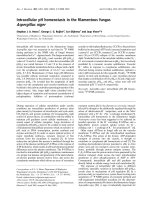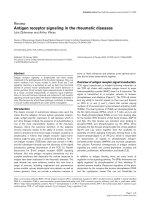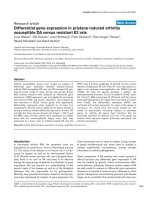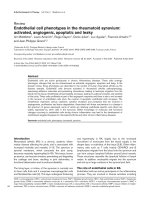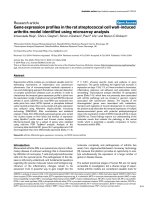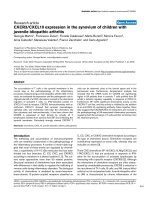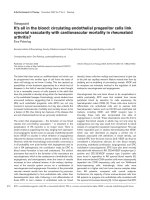Báo cáo y học: " Blood glucose control in the intensive care unit: discrepancy between belief and practice" potx
Bạn đang xem bản rút gọn của tài liệu. Xem và tải ngay bản đầy đủ của tài liệu tại đây (117.38 KB, 2 trang )
In a recent issue of Critical Care, Preissig and Rigby [1]
surveyed the attitudes and practice habits among
pediatric intensivists in the US regarding hyperglycemia
and tight glycemic control (TGC) in critically ill children.
e authors report a considerable disparity between the
convictions of the attending physicians and their actual
daily practices for blood glucose control in the intensive
care unit (ICU). Ninety-seven percent of the participants
believed that subsets of critically ill adult patients should
be treated for hyperglycemia, and 67% were convinced
that subsets of critically ill children would benefi t from
glycemic control. However, only a minority of the centers
have a standard approach for screening and treating
hyperglycemia (7%) and 80% lack a standard approach to
screen for and treat elevated blood glucose levels. is
study provides, therefore, good examples of the
discrep ancy between conviction and practice, of the
sceptic implementation of available evidence from clinical
studies, and of poor adoption of offi cial recommendations
in daily practice.
Hyperglycemia and glucose variability occur very
frequently during major surgery and critical illness. ese
metabolic responses are strongly associated with poor
outcome in many diff erent medical conditions in adults,
children, and neonates. Prospective randomized trials
comparing conventional blood glucose management with
age-adjusted TGC in adult surgical [2] and medical [3]
ICU patients and in pediatric critically ill patients [4]
demonstrated a benefi cial eff ect on morbidity and
mortality favoring TGC. Although the debate regarding
the pursued blood glucose target ranges is ongoing and
other studies [5] (albeit with a diff erent study protocol)
could not confi rm the results of the previous ‘Leuven’
trials, a majority of the medical community is convinced
that blood glucose really matters, that glycemic
management and strategy should be performed in
critically ill patients, and that excessive hyperglycemia
should be avoided.
However, routine and successful implementation of
TGC with intensive insulin therapy remains a diffi cult
hurdle to clear in many ICUs. Among the most promi-
nent reasons for this poor implementation are the fear of
evoking iatrogenic hypoglycemia and the general belief
that hypoglycemia, albeit for a brief period, is more
dangerous and harmful than sustained hyperglycemia.
is is elegantly demonstrated in the study by Preissig
and Rigby [1].
Hypoglycemia can be the result of the lack of accuracy
of the used blood glucose measurement devices, the
absence or inadequacy of guidelines and protocols to
steer the insulin therapy to achieve TGC, or both.
Implementing TGC requires frequent, rapidly available,
and accurate blood glucose measurements. However, the
high level of accuracy of blood glucose measurements
obtained in remote central laboratory facilities or with
automated blood gas analyzers cannot be reproduced by
many available bedside blood glucose devices in the
setting of critically ill patients with a disturbed ‘milieu
Abstract
A survey among pediatric intensive care physicians
showed that a great disparity exists between
physicians’ beliefs regarding hyperglycemia in critically
ill patients and their daily practices to screen and treat
hyperglycemia. One of the most prominent reasons
for hesitating to implement tight glycemic control is
the fear of evoking iatrogenic hypoglycemia. Results
from ongoing and future studies focusing on both
short- and long-term e ects of tight glycemic control
in broad populations of critically ill children can
provide further strong evidence for implementing
tight glycemic control. Improving the accuracy of
bedside blood glucose measurements and developing
reliable computer algorithms to steer insulin infusions
can help to overcome the fear of evoking iatrogenic
hypoglycemia.
© 2010 BioMed Central Ltd
Blood glucose control in the intensive care unit:
discrepancy between belief and practice
Dirk Vlasselaers*
See related research by Preissig and Rigby, />COMMENTARY
*Correspondence:
Department of Intensive Care Medicine, University Hospitals Leuven, Herestraat
49, B-3000 Leuven, Belgium
Vlasselaers Critical Care 2010, 14:145
/>© 2010 BioMed Central Ltd
interne’ (for example, acidosis, hypoxia, and hemo-
dilution) [6,7]. e current unavailability of accurate
bedside blood glucose measurements in many ICU
departments precludes safe, effi cient, and widespread
implementation of TGC. Current technology research
should focus on the development of accurate and easy-
to-use continuous blood glucose measurement equip-
ment for critically ill patients.
TGC with intensive insulin therapy increases the
workload and responsibility for bedside nurses. Frequent
blood testing, interpretation of the blood glucose results,
and fi nally adapting the insulin infusion are very demand-
ing for ICU staff . In addition, guidelines and protocols to
steer the insulin infusion are mostly rough guides and
experience and intuition are therefore mandatory for
successful implementation of TGC. In larger ICUs with a
broad medical and nursing staff , it can be a real challenge
to convince, motivate, and train the personnel to
implement TGC, as demonstrated by Preissig and Rigby
[1]. To overcome this ‘human’ factor and to avoid the use
of ineffi cient and impractical guidelines, computerized
algorithms taking into account the recent evolution of
blood glucose values, the insulin dose, the caloric intake,
and perhaps some physiologic and pharmacologic varia-
bles can be a substantial aid [8]. Incorporating an accurate
continuous blood glucose analyzer validated for critically
ill patients and an eff ective, safe, and validated computer
algorithm into a closed loop system can help to avoid
harmful clinical errors leading to iatrogenic-induced
hypoglycemia and to successful implementation of TGC.
Finally, the results of ongoing and future studies
regarding TGC in critically ill adults and children can
help to close the gap between physicians’ convictions,
attitudes, and daily practices and hence improve the
implementation of TGC. e long-term eff ects of TGC
on neurologic and cognitive development and organ
functions in children are currently being investigated by
the Leuven clinical research group. Multicenter pros pec-
tive randomized controlled trials, like the ongoing CHiP
(Control of Hyperglycemia in Pediatric Intensive Care)
trial in the UK, will provide further knowledge about this
intriguing topic.
In conclusion, as shown by Preissig and Rigby, a
majority of ICU physicians are convinced that diff erent
subsets of critically ill patients, whether adults or
children, could benefi t from TGC and that this aff ects
outcome. However, only a minority of the centers use a
standard and uniform approach to screen and treat
hyperglycemia. is con siderable disparity between
beliefs and actual practices is explained, at least partially,
by the fear of evoking hypoglycemia. Strong eff orts
should be made to improve the accuracy of bedside blood
glucose measurements in ICU patients and to develop
reliable and safe algorithms to steer insulin infusions and
avoid iatrogenic hypo glycemia.
Abbreviations
ICU, intensive care unit; TGC, tight glycemic control.
Competing interests
The author declares that he has no competing interests.
Published: 5 May 2010
References
1. Preissig CM, Rigby MR: A disparity between physician attitudes and
practice regarding hyperglycemia in pediatric intensive care units in the
United States: a survey on actual practice habits. Crit Care 2010, 14:R11.
2. Van den Berghe G, Wouters P, Weekers F, Verwaest C, Bruyninckx F, Schetz M,
Vlasselaers D, Ferdinande P, Lauwers P, Bouillon R: Intensive insulin therapy
in critically ill patients. N Engl J Med 2001, 345:1359-1367.
3. Van den Berghe G, Wilmer A, Hermans G, Meersseman W, Wouters P, Milants I,
Van Wijngaerden E, Bobbaers H, Bouillon R: Intensive insulin therapy in the
medical ICU. N Engl J Med 2006, 354:449-461.
4. Vlasselaers D, Milants I, Desmet L, Wouters PJ, Vanhorebeek I, van den Heuvel
I, Mesotten D, Casaer MP, Meyfroidt G, Ingels C, Muller J, Van Cromphaut S,
Schetz M, Van den Berghe G: Intensive insulin therapy for patients in
paediatric intensive care: a prospective, randomised controlled study.
Lancet 2009, 14:547-556.
5. NICE-SUGAR study investigators, Finfer S, Chittock DR, Su SY, Blair D, Foster D,
Dhingra V, Bellomo R, Cook D, Dodek P, Henderson WR, Hébert PC, Heritier S,
Heyland DK, McArthur C, McDonald E, Mitchell I, Myburgh JA, Norton R,
Potter J, Robinson BG, Ronco JJ: Intensive versus conventional glucose
control in critically ill patients. N Engl J Med 2009, 360:1283-1297.
6. Vlasselaers D, Van Herpe T, Milants I, Eerdekens M, Wouters PJ, De Moor B, Van
den Berghe G: Blood glucose measurements in arterial blood of ICU
patients submitted to tight glycemic control: agreement between
bedside tests. J Diabetes Sci Technol 2008, 2:932-938.
7. Rice M, Pitkin A, Coursin D: Glucose measurement in the operating room:
more complicated than it seems. Anesth Analg 2010, 110:1056-1065.
8. Cordingley JJ, Vlasselaers D, Dormand NC, Wouters PJ, Squire SD, Chassin LJ,
Wilinska ME, Morgan CJ, Hovorka R, Van den Berghe G: Intensive insulin
therapy: enhanced model predictive control algorithm versus standard
care. Intensive Care Med 2009, 35:123-128.
doi:10.1186/cc8984
Cite this article as: Vlasselaers D: Blood glucose control in the intensive care
unit: discrepancy between belief and practice. Critical Care 2010, 14:145.
Vlasselaers Critical Care 2010, 14:145
/>Page 2 of 2


